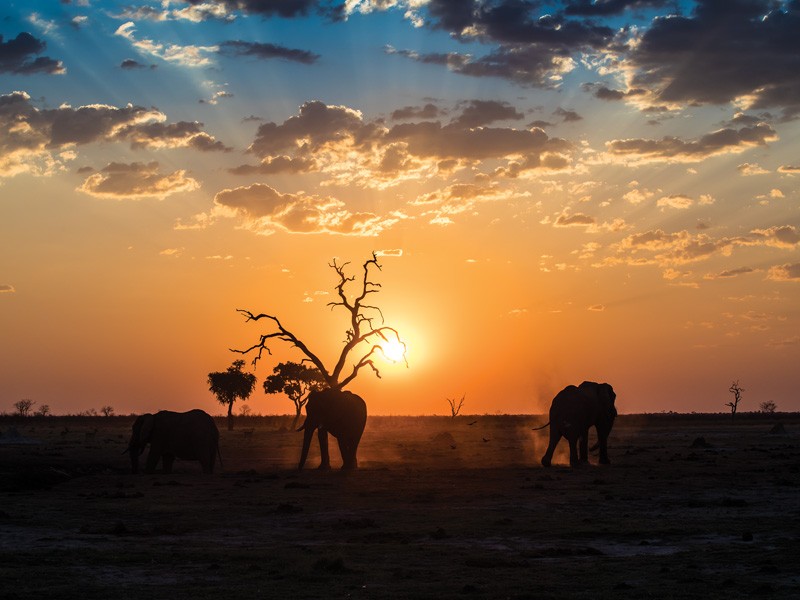Hunting and anti-poaching in Botswana
Correspondent | Friday March 29, 2019 13:46


Putting aside for now the ill-advised and predictably inflammatory statement that there could be some management of the elephant population, including limited culling, let’s consider some facts.
During the latest elephant census carried out to extremely high standards by EWB, a number of elephant poaching “hotspots” were recorded. The reporting of these has resulted in an irresponsible hysteria in the press and unpleasant accusations and innuendo from many sources. Maybe we shouldn’t expect the press to understand the statistics behind the survey results, which indicate similar numbers to the previous survey in 2014, not a catastrophic decline, but they should try to get to the truth, especially as their correspondents seem not even slightly familiar with the greater Botswana environment.
Many of the “hotspots” apparently occur in areas of northern Botswana’s elephant range which are among the most highly valued photographic areas, leased to large international tourism companies and patrolled by the BDF from embedded bases in the areas. Others are in more remote areas where there is no tourism presence and almost no antipoaching activity, such as the vast area between the Northern buffalo fence and the Okavango RIver, where a reported 20,000 elephants provide a lucrative target.
The surprising irony is that the prime photographic areas and the most remote areas seem to be easy pickings. But the photographic operations only utilise a small fraction of their leased areas on a regular and predictable basis, mainly sticking to favourite waterholes and main roads. This leaves large areas untouched and vulnerable to poachers - the same as in the remote wilderness areas.
Twenty years ago a Land Use and Development Plan for the Okavango and its surrounding areas laid out a balanced prescription for the conservation of those areas with multiple land uses. The plan was prepared at a cost of millions, by a diverse team of highly qualified experts in consultation with local government and communities. It prescribed areas for exclusive photographic tourism, multi-use areas for safari hunting and tourism based on detailed management plans, and community areas. It worked well. Contrast this with today’s situation where the vast majority of areas are for exclusive photographic tourism and there is no hunting at all. The main results have been resentment and poaching, not just the highly publicised killing of elephants and rhino, but a massive offtake of illegal bushmeat.
Legal, well administered and well managed consumptive resource use can alleviate both of these serious problems. Hunting is a viable land use and can take place alongside photographic tourism, despite what the big operators preach. Some fanatical green and sentimental tourists might be put off, but there will not be a significant drop in numbers as claimed by the big companies jealously protecting their exclusive rights. This is merely scaremongering.
In areas with legitimate hunting activities the poaching will reduce almost to zero. There will be a small regulated offtake instead of the uncontrolled looting we see now. The smaller, exclusive photographic zones will also be better protected. Hunting areas are randomly well patrolled by skilled bush operatives who have a strong incentive to protect the resources from outsiders. Their activities are not limited to predictable routes, but penetrate the whole area in relation to animal movements - just as poachers do. These people are drawn from rural communities and have the necessary skills to detect and deter poachers. Unfortunately, most BDF antipoaching personnel do not have the motivation, innate knowledge and skill to prevent poaching except in occasional armed confrontations. They are soldiers, not safari trackers. The location of poaching hotspots in proximity to BDF camps and up-market lodges bears witness to this.
Safari hunting has a place in a balanced natural resource and land management programme, but it must be better managed and controlled than before.
Many of us are aware of lawbreaking and unethical practices by the previous safari companies. These must be stamped out by a strong code of practice enforced by law and an efficient government administration, with hunters and safari staff having a dual role including combating illegal activities and extending the reach of the authorities.
*Dr Larry Patterson is an experienced wildlife biologist and veterinarian with 48 years of experience in Botswana. He was responsible for many of the DWNP aerial censuses in the 1970’s and 1980’s, mainly counting elephant, He also worked for the Kalahari Conservation Society and assisted with monitoring the safari hunting industry for DWNP.
